高一英语必修一unit1教案
- 格式:pdf
- 大小:99.17 KB
- 文档页数:2
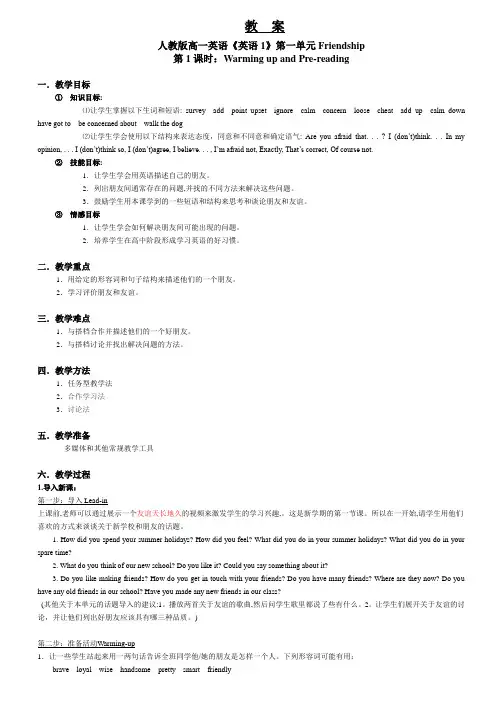
教案人教版高一英语《英语1》第一单元Friendship第1课时:Warming up and Pre-reading一.教学目标①知识目标:⑴让学生掌握以下生词和短语: survey add point upset ignore calm concern loose cheat add up calm down have got to be concerned about walk the dog⑵让学生学会使用以下结构来表达态度,同意和不同意和确定语气: Are you afraid that. . . ? I (don’t)think. . . In my opinion, . . . I (don’t)think so, I (don’t)agree, I believe. . . , I’m afraid not, Exactly, That’s correct, Of course not.②技能目标:1.让学生学会用英语描述自己的朋友。
2.列出朋友间通常存在的问题,并找的不同方法来解决这些问题。
3.鼓励学生用本课学到的一些短语和结构来思考和谈论朋友和友谊。
③情感目标1.让学生学会如何解决朋友间可能出现的问题。
2.培养学生在高中阶段形成学习英语的好习惯。
二.教学重点1.用给定的形容词和句子结构来描述他们的一个朋友。
2.学习评价朋友和友谊。
三.教学难点1.与搭档合作并描述他们的一个好朋友。
2.与搭档讨论并找出解决问题的方法。
四.教学方法1.任务型教学法2.合作学习法3.讨论法五.教学准备多媒体和其他常规教学工具六.教学过程1.导入新课:第一步:导入Lead-in上课前,老师可以通过展示一个友谊天长地久的视频来激发学生的学习兴趣,。
这是新学期的第一节课。
所以在一开始,请学生用他们喜欢的方式来谈谈关于新学校和朋友的话题。
1. How did you spend your summer holidays? How did you feel? What did you do in your summer holidays? What did you do in your spare time?2. What do you think of our new school? Do you like it? Could you say something about it?3. Do you like making friends? How do you get in touch with your friends? Do you have many friends? Where are they now? Do you have any old friends in our school? Have you made any new friends in our class?(其他关于本单元的话题导入的建议:1。
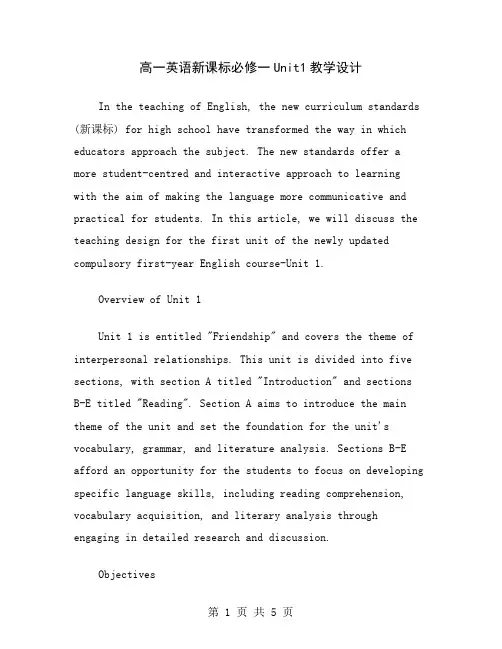
高一英语新课标必修一Unit1教学设计In the teaching of English, the new curriculum standards (新课标) for high school have transformed the way in which educators approach the subject. The new standards offer a more student-centred and interactive approach to learning with the aim of making the language more communicative and practical for students. In this article, we will discuss the teaching design for the first unit of the newly updated compulsory first-year English course-Unit 1.Overview of Unit 1Unit 1 is entitled "Friendship" and covers the theme of interpersonal relationships. This unit is divided into five sections, with section A titled "Introduction" and sections B-E titled "Reading". Section A aims to introduce the main theme of the unit and set the foundation for the unit's vocabulary, grammar, and literature analysis. Sections B-E afford an opportunity for the students to focus on developing specific language skills, including reading comprehension, vocabulary acquisition, and literary analysis through engaging in detailed research and discussion.ObjectivesThere are several objectives to be considered when designing a lesson for Unit 1. The objectives are set to ensure that each student can develop important English language skills and to equip them with the necessary tools to navigate interpersonal relationships in the English-speaking world. These objectives include:1.To enable students to identify different aspects offriendship and their significance.2.To equip students with a variety of reading skills,including the ability to analyze genre and literarydevices and to effectively summarize and paraphrasewritten passages.3.To help students to develop their vocabulary andthe skills to identify and use academic and everydayEnglish phrases and idioms.4.To help students understand the role of language ininterpersonal relationships and how to use differentlanguage structures to perform different social functions.5.To foster cooperative and collaborative groupdiscussion among students and encourage them to workeffectively as part of a team.Teaching StrategiesTo achieve the teaching objectives for unit 1, there are several teaching strategies that may be employed, including:1.Group WorkGroup work is an excellent tool for encouraging students to work effectively as part of a team and collaborate with their peers. This strategy is especially useful when teaching the topic of friendship as it gives students the opportunity to engage with one another and share their experiences.2.Pair WorkPair work is a useful strategy for promoting student interaction and facilitating peer support. This strategy allows students to work together, offering each other support and feedback, improving their communication and language skills.3.Role PlayRole-play encourages students to practice their language skills in real-world scenarios. It helps students to gain confidence in their communication abilities and use language for different social situations.4.Reading StrategiesReading strategies help students develop their reading and comprehension skills, enabling them to analyze and interpret different texts effectively. These skills also help students to explore the themes and motifs of the literature, leading to a deeper understanding and appreciation of the text.ConclusionThis article has discussed the unit 1 teaching design for the newly updated first-year English course for high school students. The objectives and teaching strategies covered in this article are aimed at providing the students with a more interactive and student-centred approach to learning English language skills. The strategies aim to foster critical thinking, creativity, and collaboration among students, helping them to develop skills that are essential for successin the English-speaking world. Teachers can use this design as a template to design their class plan, adapting the activities to students' individual needs and learning styles.。
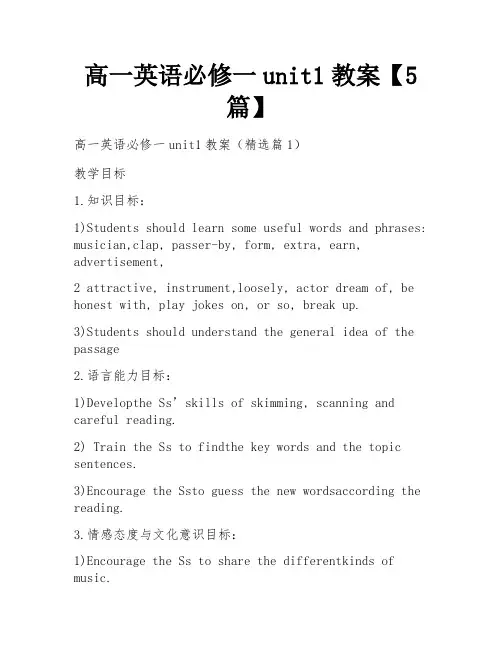
高一英语必修一unit1教案【5篇】高一英语必修一unit1教案(精选篇1)教学目标1.知识目标:1)Students should learn some useful words and phrases: musician,clap, passer-by, form, extra, earn, advertisement,2 attractive, instrument,loosely, actor dream of, be honest with, play jokes on, or so, break up.3)Students should understand the general idea of the passage2.语言能力目标:1)Developthe Ss’skills of skimming, scanning and careful reading.2) Train the Ss to findthe key words and the topic sentences.3)Encourage the Ssto guess the new wordsaccording the reading.3.情感态度与文化意识目标:1)Encourage the Ss to share the differentkinds of music.2)Improve the cooperation and share among the students.教学重难点1、教学重点:a.To understudend the passage better b.To find the main idea of eachparagraph2、教学难点:a.Master the reading ability b.Develop the skills ofreading教学过程教学设计本节课共45分钟,具体教学步骤如下:Step I Leading-in播放一段小视频,内容为歌曲 If you arehappy的英文版本,通过介绍演唱乐队twins引出本单元话题。
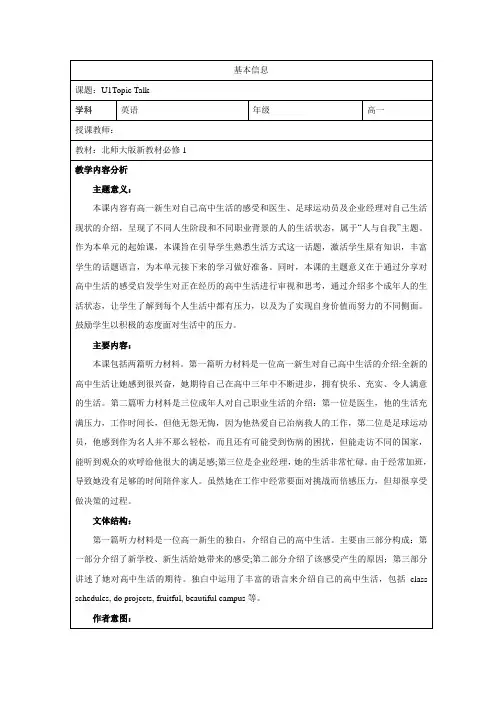
作者希望学生通过学习第一篇听力材料,了解同龄人的高中生活状况和对高中生活的期待,并基于此审视自己的高中生活,以听力材料为语言支持,表达高中生活给自己的感受和自己对高中生活的期待。
作者希望学生通过学习第二篇听力材料,了解到不同职业的人的生活状态,理解不同职业都有自己的精彩和压力。
教学目标:在本课学习结束时,学生能够:1.获取并梳理听力文本中的主要信;2.基于所学清晰有条理的介绍自己的学校生活;3.比较不同职业的生活方式的异同,学习他们积极的生活态度。
教学设计:教学目标教学活动与步骤设计意图1.一获取并梳理听力文本中的主要信息。
Step1Talk about your new school life. Use the cues in activity oneon page 6 to help you.Step2Listen to a talk given by a student who is a new seniorsecondary school student and complete the text builder onpage 6.I’m a new senior secondary school student. My new schoollife is very_____.I feel excited because this school_____.What is also very different is that students in the sameclass______.Step1引入话题,激活学生已有知识。
Step2引导学生理解听力信息。
Step3指导学生学习语言,为谈论自己的生活做好准备。
Step4启发学生发现文本内部逻辑。
In the next three years, I hope I will_____.Step3Find out which statements in the text builder are true to the students.Step4Analyze the logic in the talk.2.基于所学清晰,有条理的介绍自己的学校生活。
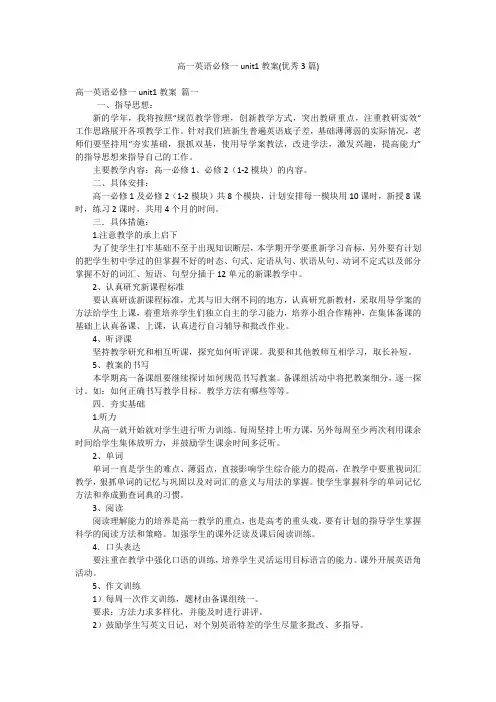
高一英语必修一unit1教案(优秀3篇)高一英语必修一unit1教案篇一一、指导思想:新的学年,我将按照“规范教学管理,创新教学方式,突出教研重点,注重教研实效”工作思路展开各项教学工作。
针对我们班新生普遍英语底子差,基础薄薄弱的实际情况,老师们要坚持用“夯实基础,狠抓双基,使用导学案教法,改进学法,激发兴趣,提高能力”的指导思想来指导自己的工作。
主要教学内容:高一必修1、必修2(1-2模块)的内容。
二、具体安排:高一必修1及必修2(1-2模块)共8个模块,计划安排每一模块用10课时,新授8课时,练习2课时,共用4个月的时间。
三.具体措施:1.注意教学的承上启下为了使学生打牢基础不至于出现知识断层,本学期开学要重新学习音标,另外要有计划的把学生初中学过的但掌握不好的时态、句式、定语从句、状语从句、动词不定式以及部分掌握不好的词汇、短语、句型分插于12单元的新课教学中。
2、认真研究新课程标准要认真研读新课程标准,尤其与旧大纲不同的地方,认真研究新教材,采取用导学案的方法给学生上课,着重培养学生们独立自主的学习能力,培养小组合作精神,在集体备课的基础上认真备课、上课,认真进行自习辅导和批改作业。
4、听评课坚持教学研究和相互听课,探究如何听评课。
我要和其他教师互相学习,取长补短。
5、教案的书写本学期高一备课组要继续探讨如何规范书写教案。
备课组活动中将把教案细分,逐一探讨。
如:如何正确书写教学目标。
教学方法有哪些等等。
四.夯实基础1.听力从高一就开始就对学生进行听力训练。
每周坚持上听力课,另外每周至少两次利用课余时间给学生集体放听力,并鼓励学生课余时间多泛听。
2、单词单词一直是学生的难点、薄弱点,直接影响学生综合能力的提高,在教学中要重视词汇教学,狠抓单词的记忆与巩固以及对词汇的意义与用法的掌握。
使学生掌握科学的单词记忆方法和养成勤查词典的习惯。
3、阅读阅读理解能力的培养是高一教学的重点,也是高考的重头戏。
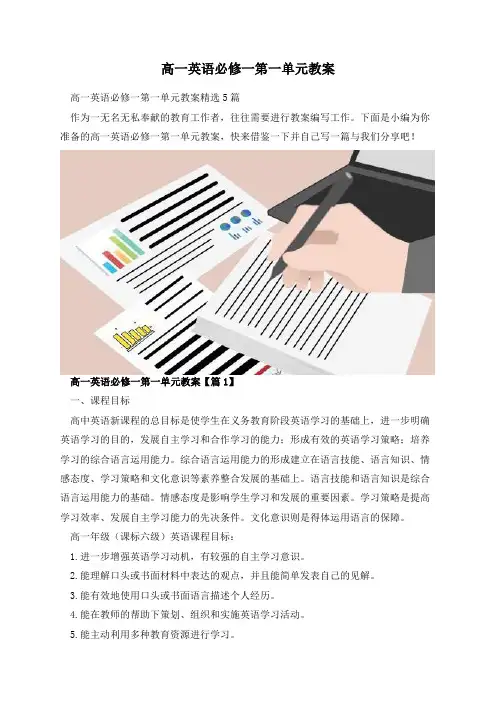
高一英语必修一第一单元教案高一英语必修一第一单元教案精选5篇作为一无名无私奉献的教育工作者,往往需要进行教案编写工作。
下面是小编为你准备的高一英语必修一第一单元教案,快来借鉴一下并自己写一篇与我们分享吧!高一英语必修一第一单元教案【篇1】一、课程目标高中英语新课程的总目标是使学生在义务教育阶段英语学习的基础上,进一步明确英语学习的目的,发展自主学习和合作学习的能力;形成有效的英语学习策略;培养学习的综合语言运用能力。
综合语言运用能力的形成建立在语言技能、语言知识、情感态度、学习策略和文化意识等素养整合发展的基础上。
语言技能和语言知识是综合语言运用能力的基础。
情感态度是影响学生学习和发展的重要因素。
学习策略是提高学习效率、发展自主学习能力的先决条件。
文化意识则是得体运用语言的保障。
高一年级(课标六级)英语课程目标:1.进一步增强英语学习动机,有较强的自主学习意识。
2.能理解口头或书面材料中表达的观点,并且能简单发表自己的见解。
3.能有效地使用口头或书面语言描述个人经历。
4.能在教师的帮助下策划、组织和实施英语学习活动。
5.能主动利用多种教育资源进行学习。
6.能初步对学习过程和结果进行自我评价,调整自己学习目标和策略。
7.能体会交际中所使用语言的文化内涵和背景。
高一年级(课标七级)英语课程目标:1.有明确和持续的学习动机和自主学习意识。
2.能就熟悉的话题交流信息,提出问题并且陈述自己的意见和建议。
3.能读懂供高中学生阅读的英文原著简写本及英语报刊。
4.具有初步的实用写作能力,例如:事务通知和邀请信等。
5.能在教师的指导下,主动参与计划、组织和实施语言实践活动。
6.能主动扩展和利用学习资源,从多渠道获取信息,并能利用所获得的信息进行清楚和有条理的表达。
7.具有较强的自我评价和自我调控能力,基本形成适合自己的学习策略。
8.理解交际中的文化差异,初步形成跨文化交际意识。
二、课程内容完成牛津英语第三第四模块的全部内容。
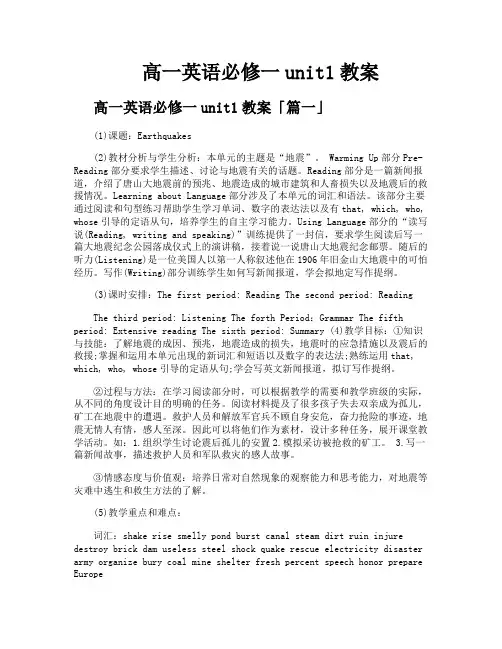
高一英语必修一unit1教案高一英语必修一unit1教案「篇一」(1)课题:Earthquakes(2)教材分析与学生分析:本单元的主题是“地震”。
Warming Up部分Pre-Reading部分要求学生描述、讨论与地震有关的话题。
Reading部分是一篇新闻报道,介绍了唐山大地震前的预兆、地震造成的城市建筑和人畜损失以及地震后的救援情况。
Learning about Language部分涉及了本单元的词汇和语法。
该部分主要通过阅读和句型练习帮助学生学习单词、数字的表达法以及有that, which, who, whose引导的定语从句,培养学生的自主学习能力。
Using Language部分的“读写说(Reading, writing and speaking)”训练提供了一封信,要求学生阅读后写一篇大地震纪念公园落成仪式上的演讲稿,接着说一说唐山大地震纪念邮票。
随后的听力(Listening)是一位美国人以第一人称叙述他在1906年旧金山大地震中的可怕经历。
写作(Writing)部分训练学生如何写新闻报道,学会拟地定写作提纲。
(3)课时安排:The first period: Reading The second period: ReadingThe third period: Listening The forth Period:Grammar The fifth period: Extensive reading The sixth period: Summary (4)教学目标:①知识与技能:了解地震的成因、预兆,地震造成的损失,地震时的应急措施以及震后的救援;掌握和运用本单元出现的新词汇和短语以及数字的表达法;熟练运用that, which, who, whose引导的定语从句;学会写英文新闻报道,拟订写作提纲。
②过程与方法:在学习阅读部分时,可以根据教学的需要和教学班级的实际,从不同的角度设计目的明确的任务。
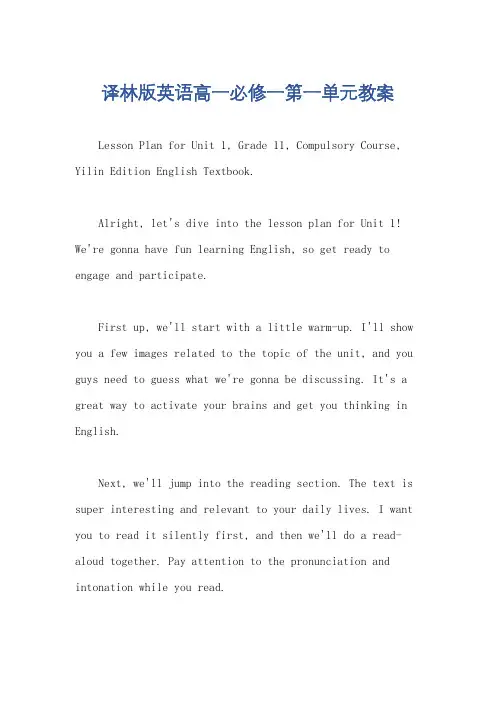
译林版英语高一必修一第一单元教案Lesson Plan for Unit 1, Grade 11, Compulsory Course, Yilin Edition English Textbook.Alright, let's dive into the lesson plan for Unit 1! We're gonna have fun learning English, so get ready to engage and participate.First up, we'll start with a little warm-up. I'll show you a few images related to the topic of the unit, and you guys need to guess what we're gonna be discussing. It's a great way to activate your brains and get you thinking in English.Next, we'll jump into the reading section. The text is super interesting and relevant to your daily lives. I want you to read it silently first, and then we'll do a read-aloud together. Pay attention to the pronunciation and intonation while you read.After that, let's break down the vocabulary. We'll go through the new words and expressions, and I'll give you some tips on how to remember them. But don't just memorize them – try to use them in sentences! That's the best way to learn.Grammar time! We'll be focusing on a particular grammar point in this unit. I'll explain it clearly and give you plenty of examples. But don'。
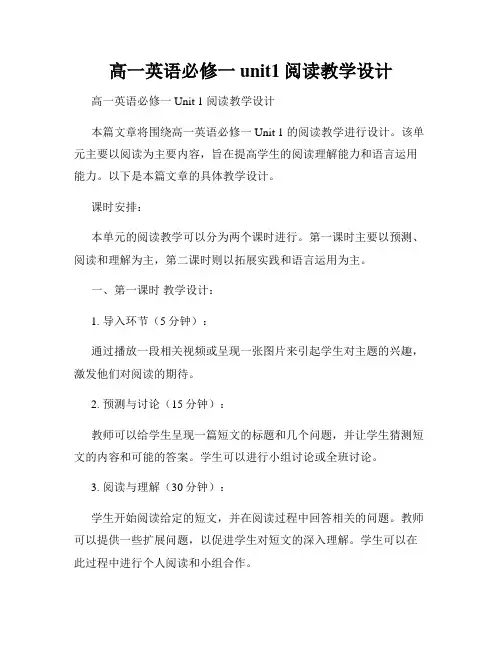
高一英语必修一unit1阅读教学设计高一英语必修一 Unit 1 阅读教学设计本篇文章将围绕高一英语必修一 Unit 1 的阅读教学进行设计。
该单元主要以阅读为主要内容,旨在提高学生的阅读理解能力和语言运用能力。
以下是本篇文章的具体教学设计。
课时安排:本单元的阅读教学可以分为两个课时进行。
第一课时主要以预测、阅读和理解为主,第二课时则以拓展实践和语言运用为主。
一、第一课时教学设计:1. 导入环节(5分钟):通过播放一段相关视频或呈现一张图片来引起学生对主题的兴趣,激发他们对阅读的期待。
2. 预测与讨论(15分钟):教师可以给学生呈现一篇短文的标题和几个问题,并让学生猜测短文的内容和可能的答案。
学生可以进行小组讨论或全班讨论。
3. 阅读与理解(30分钟):学生开始阅读给定的短文,并在阅读过程中回答相关的问题。
教师可以提供一些扩展问题,以促进学生对短文的深入理解。
学生可以在此过程中进行个人阅读和小组合作。
4. 总结与讲解(20分钟):教师对学生的回答进行总结,并对短文中的重点内容进行讲解。
教师可以采用板书或PPT的形式呈现重点内容,以便学生更好地理解和记忆。
二、第二课时教学设计:1. 复习与回顾(10分钟):教师可以通过回顾上一课时学习的重点内容来帮助学生温习和巩固知识。
2. 拓展实践(30分钟):教师可以设计一些与短文内容相关的活动,如角色扮演、小组辩论或问题解决等,以帮助学生更好地理解和运用所学知识。
3. 语言运用(30分钟):教师可以设计一些与短文相关的语法和词汇练习,如填空、翻译或作文等,以巩固学生在阅读中学到的语言知识和技巧。
4. 总结与反馈(10分钟):教师可以对学生在语言运用环节中的表现进行总结和反馈,鼓励他们不断提高。
总结:通过以上的教学设计,学生将能够在阅读教学中提高自己的阅读理解能力和语言运用能力。
教师在实施教学时应根据学生的实际情况进行调整,并注重培养学生的自主学习能力和团队合作精神。
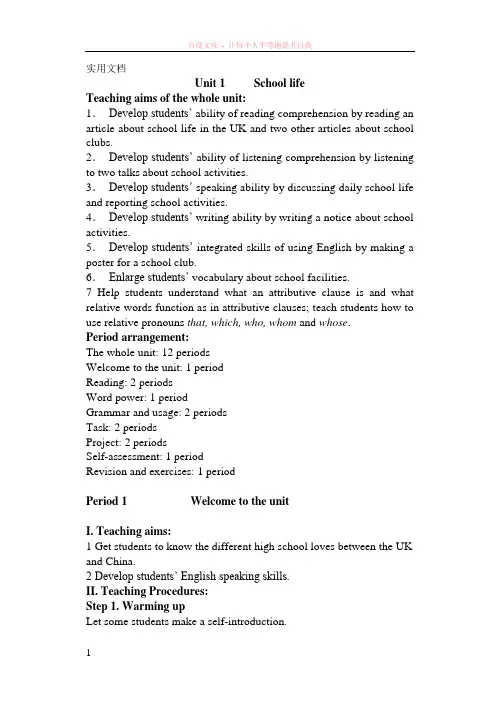
Unit 1 School lifeTeaching aims of the whole unit:1.Develop students’ ability of reading comprehension by reading an article about school life in the UK and two other articles about school clubs.2.Develop students’ ability of listening comprehension by listening to two talks about school activities.3.Develop students’ speaking ability by discussing daily school life and reporting school activities.4.Develop students’ writing ability by writing a notice about school activities.5.Develop students’ integrated skills of using English by making a poster for a school club.6.Enlarge students’ vocabulary about school facilities.7 Help students understand what an attributive clause is and what relative words function as in attributive clauses; teach students how to use relative pronouns that, which, who, whom and whose.Period arrangement:The whole unit: 12 periodsWelcome to the unit: 1 periodReading: 2 periodsWord power: 1 periodGrammar and usage: 2 periodsTask: 2 periodsProject: 2 periodsSelf-assessment: 1 periodRevision and exercises: 1 periodPeriod 1 Welcome to the unitI. Teaching aims:1 Get students to know the different high school loves between the UK and China.2 Develop students’ English speaking skills.II. Teaching Procedures:Step 1. Warming upLet some students make a self-introduction.1. Introduce themselves.2. Say something about their junior high school life.3. Pair work: brain storm:When we are talking about our school life, what will we probably think of?What words or phrases will we use to describe our school life? Step 2 Presentation1.Say the following to students:It’s the beginni ng of the new term. You’ve just finished your junior high and are about to enter a new period in your studies. I am happy to give your lessons and I hope we can be friends.I can see that some of your are eager to know what studying at senior high will be like. Will it be differ4ent from junior high? Well, there are certainly many differences between junior high and senior high, but there are also some things that are the same in every school in China. What about schools in other countries? Do you have different experiences? Are schools all over the world the same? This is the subject of our first unit.2. Ask students to read the instruction and tell them:Here are three pictures that show some aspects of school life in the UK. Please read the instructions, look at the pictures: what's the difference between schools in China and the UK?Step 3 Discussion1 Ask students the following questions to talk about the words in the four pictures:Huge campus and low-rise buildingsWhat does huge mean?What does low-rise mean?What about campus and school buildings in China?(Schools in China usually have a large enough campus to make sure students have enough space to study and play. But most school buildings have at least 3 storeys.)Lockers for every studentDo you know what a locker is?(There are rows of lockers by the classrooms for students to put their bookd, exercise-books and other belongings.)What do you think about locker for students?Do you think that we should have such locker in our school? Why or Why not?Fewer students in each classHow many students are there in our class?Do you know the number of students in a class in the UK?At ease with our teacherWhat can we know from this picture?What does the word ease mean? What do you think the phrase at ease mean?Were you getting on well with the teacher when you were in junior high?What relationship do you want to have with your teachers in senior high?2 Ask students to work in groups to talk about the four pictures and the differences between schools in the UK and China. Then ask several students to report their discussion to the whole class.aspects In the UK In ChinaHuge campus and low-rise buildings We can see hugecampus andlow-rise buildings.It is the biggestdifference fromschools in ChinaSchools in China usually have alarge enough campus to make surestudents have enough space tostudy and play in.But most school buildings aretaller, at least three storeys.Lockers for every student There are rows oflockers by theclassrooms forstudents to put theirstationary, books,exercise-books andother belongings.Students bring what they need forlessons to school and then take itall back home after school. Mostschools in china do not haveequipment in the classroom.Fewer students in each class There are fewerstudents in a class,no more than 30 perThere are usually more students inhigh school, perhaps 40 to 50 perclass. Recently some schools areclass. beginning to limit the number ofstudents in each class.At ease with our teacher Students have aclose relationshipwith their teachers.They feel at easeand comfortablewith them.It is similar in china. Nowadays,lots of teachers and students haveestablished a good relationshipwith each other. They respect eachother and work to gain a betterunderstanding of each other.3. Ask students to discuss the three questions in pairs, and them ask some of them to report their answers to the questions to the whole class.What is your dream school life like?What kind of school activities do you enjoy?What do you think of your life here in the new school?Step 4 Summary and HomeworkToday we’ve mainly talked about the differences between the high school lives in the UK and in China. After class you should:1) Recall all the new words and expressions that we learn in this lesson.2) Find more about any other differences between the high school lives in the UK and in China, either by surf the Internet or by reading some articles in newspapers or magazines.3) Preview the following part: reading (page 2 to page 4).Period 2 Reading (1) School life in the UKTeaching aims:1. Get students to know what school life is like in a high school in the UK.2. Develop students’ ability of reading comprehension through:1)skimming and scanning.2)Guessing the meanings of some new words from the context3. To learn some expressions about school life.Teaching procedures:Step 1 Lead-in and PresentationSay the following to the students:Yesterday we’ve talked about the differences between the high school lives in the UK and in China. We know well about the high school lives in China, because we are Chinese. But we know a little about the high school lives in the UK. Yeah? Today we are going to read a magazine article which is written by an exchanging student. She has been studying in the UK for one year. Now she gives a clear brief introduction about her school life there.(Bb: School life in the UK) Before we read the article, we are going to learn the reading strategy: skimming and scanning.Please look at page 3: Reading strategy. (Bb the following while learning the reading strategy. )Skimming: to get a general idea of the article, without studying it in detail.Focus on the titles, headings, the first and last sentences or paragraphs, charts and pictures …scanning: to find certain information in an article quickly.Look for key words and phrases, dates and numbers, etc.Step 2. Reading1. Skimming:Question: How does Wei Hua feel about her life in the UK?2. Scanning:1)Ask students to go through the three questions in part A and makesure that each of them know the meaning of each question.(AWoodwork class is a class in which students make somethingfrom wood.)Ask students to read the passage as quickly as possible and try to find answers to the three questions. Remind students only tofocus on and identify the most important information.2)Ask student to reread the passage and complete Part C1individually. Then ask some of them to give the answers to thequestions in Part C13)Ask students to finish Part C2 individually. Then get somestudents to share their answers with the whole class. Ask them to say the true sentences to correct the false ones.3 GuessingAsk students to finish Part D individually. Tell them not to look up the meanings of the words from the wordlists in the textbook. Let themguess the meanings from the context. Then check the answers with the whole class.Step 3 New Words in this UnitStudy the new words appears from page2 to page 5 (from attend to immediately) at page 68.Step 4. Homework.1. Complete part E on page 5.2. Read the two articles in reading on pages 82 and 83 in wb and answers the questions below them.3. Learn all the new words we learned today by heart.Period 3 Reading (2) School life in the UKTeaching aims:1 Help students become more familiar with the article.2 Develop students’ ability of reading comprehension by finding out what topics are covered in the article.3 Develop students’ ability of speaking by discussing the subjects they like in school.Teaching Procedures:Step 1. Revision:Check the homework:1)Have a dictation to go over the words learned last period.2)Check the answers in reading on pages 82 and 83 in wb.3)Ask some students to read the article in Part E to check whetherthey have used the suitable word in each blank.Step 2 Reading1) Ask some students to read the article aloud paragraph by paragraph. Ask other students to find out what topics are covered in it.School hoursSchool assemblyTeachersClass sizeDifferent classes in different classroomsHomeworkSubjects and favourite subjectsWhat to do at lunchtimeBritish food3)Ask students to point out the different high school lives in the UKand in China in these topics.Step 3 DiscussionLet students look at Part F together and discuss the questions in Part F in Pairs. Then get some pairs to act out their discussion in class.Step 4 Language focus1 Ask students to find out the following words, phrases and sentences in the article. Then give some explanations.Words:a)as (since, because, for)b)attend (join, join in, take part in)c)prepared)experiencee)respectf)exciting, excitedg)dropPhrases:a)for freeb)be happy withc)used to do sth.; be/get used to do sth.; be/get used to doing sth.d)the way to do; the way of doing; the way + Attributive Clausee)at the end of; in the end; by the end off)as … asSentences:a)Going to a British school for one year has been a very enjoyableand exciting experience for me.b)I do like eating.c)We also had different students in some class, so it was difficult toremember all the faces and names.2 Ask students to put the following sentences into English in their exercise-books.1) Jim 加入了我们的讨论之列。
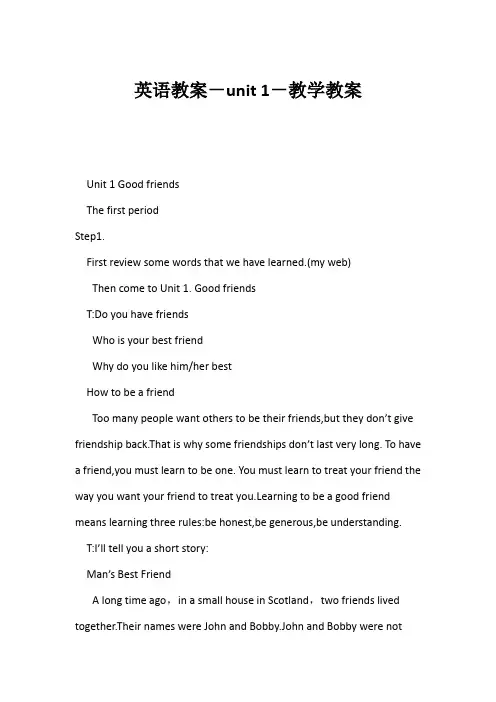
英语教案-unit 1-教学教案Unit 1 Good friendsThe first periodStep1.First review some words that we have learned.(my web)Then come to Unit 1. Good friendsT:Do you have friendsWho is your best friendWhy do you like him/her bestHow to be a friendToo many people want others to be their friends,but they don’t give friendship back.That is why some friendships don’t last very long. To have a friend,you must learn to be one. You must learn to treat your friend the way you want your friend to treat you.Learning to be a good friend means learning three rules:be honest,be generous,be understanding. T:I’ll tell you a short story:Man’s Best FriendA long time ago,in a small house in Scotland,two friends lived together.Their names were John and Bobby.John and Bobby were notrich,but they were happy.They had a warm fire when it was cold outside.They had good food to eat when they were hungry.They were never lonely because they had each other.John and Bobby liked to take long walks together.After their walk,John usually cooked dinner.John and Bobby ate dinner and then sat in front of the fire.They had a simple but good life.Then,in the spring of 1858,John got sick and died.He was buried in a cemetery in Edinburgh,Scotland.After John was buried,Bobby stood at John’s grave and cried.“Come on,Bobby,〞friends said.“It’s time to go home.〞Bobby went home,but later he returned to the cemetery.He sat down near John’s grave.He stayed there all night.Bobby stayed at the cemetery the next day,and the next day,and the next.For the next 14 years,Bobby never left the cemetery.When the weather was cold or rainy,he slept in a small house at the cemetery.When the weather was warm,he slept on the ground near John’s grave.Finally,in 1872,Bobby died,too.Friends buried him in a little grave near John.Why was Bobby’s grave littleBobby,John’s best friend,was a dog.Step2.Let’s come to Warming up.T:OK.Now I want you to discuss two questions.1.What should a good friend be like2.What qualities should a good friend haveDiscuss them in groups of four.After a while,everyone is asked to make a sentence using the words in the box below. Of course,you can use other words if you like.Add some words to describe persons:Diligent,confident,silent,selfish,unselfish,patient,easy-going,out-going(外向),talkative,humourous,strict,naughty,gentle,shy,quiet,warm-hearted,g ood-tempered,reliableNow,ask Ss to describe a good friend.Time permitting,ask more while speaking,Ss can use such phrase as〞I think…/In my opinion…〞S1:… S2:….Then Ss describe themselves in three adjectiveStep3.ListeningYou are going to hear two friends arguing.They are talking about some common problems that may occur in a friendship.What are they arguing aboutHow to solve their problemsNow listen carefully,write down what you hear.Play each situation twice.At last I’ll check the answer with the whole class,Is that clear (While playing the tape,pause for Ss to write down the information).Then check.Step4.SpeakingT:Now.I’d like to know something about your favourite hobbies (Come up to one boy).What are your favourite hobbiesWhat about you(to another s)T:yes,we know different people can have different hobbies.Now look at the part—“Speaking〞on P2.You are given four minutes to read the following self-introduction.After that,fill in the following form.……Check their answers.Now discuss in pairs who could be friends according to the form which you filled in just now. Of course,you’d better give your partner your reasons.When you express your ideas,you can use such sentence structure.1. I’m sure_____and_____could be friends,because…2. I’m not sure if____and____could be friends,because…3. Perhaps____and_____could be friends because…The Second PeriodStep1.Check the Pre-reading e to Reading.First listen to the tape and then answer the three questions on the screen:1. What does Chuck Noland do2. Does Chuck have any friend on the island Who3.What does Chuck learn about himself when he is alone on the island Then Ss read the text againStep3.Fill in the blanks according to the text:In the movie Cast Away Tom _____a man ______Chuck Noland. Chuck is a __________who is always___ busy _____he has little time for his friends. His company is to send____ all over the world. One day Chuck is on a_____ across the Pacif。
高一英语必修一教案:Unit1以下是作者为大家整理的关于《高一英语必修一教案:Unit1》,供大家学习参考!Teaching aims:1. 能力目标:a. Listening: get information and views from thelistening material;b. Speaking: express one’s attitude or views aboutfriends and friendship in appropriate words.c. Reading: enable the Ss to get the main idead. Writing: write some advice about making friend as an editor2. 知识目标:a. Talk about friends and friendship; how to make friends; how to maintain friendshipb. Use the following expressions:I think so. / I don’t think so.I agree. / I don’t agree.That’s correct.Of course not.Exactly.I’m afraid not.c. to enable the Ss to control direct speech and indirect speechd. vocabulary: add point upset calm concern careless loose cheat reason list share feeling thought German series outdoors crazy moonlight purpose dare thunder entirely power according trust indoors suffer teenager advice quiz editor communicate situation habitadd up calm down have got to be concerned about walk the dog go through hide away set down a series of on purpose in order to face to face according to get along with fall in love join in3. 情感目标:a. To arose Ss’ interest in learning English;b. To encourage Ss to be active in the activities and make Ss to be confident;c. To develop the ability to cooperate with others.4. 策略目标:a. To develop Ss’ cognitive strategy: taking notes while listening;b. To develop Ss’ communicative strategies.5. 文化目标:to enable the Ss to get to know different opinions about making friends from different countries.Teaching steps:Period oneStep1. Warm-up1. Ss listen to an English song AULD LANG SYNE.2. Brainstorming: let Ss say some words about friendship– honest, friendly, brave, humorous, funny, wise, kind, open-minded, responsible, helpful….Step 2. Talk about your old friends1. Ss talk about their old friends in Junior Middle School, talk about their appearance, personality, hobbies, etc.2. Self-introductionStep 3. Make new friends1. Ss go around and ask their new friends someinformation and fill in the following formName Age/hobbies/favorite sports, books, …2. Report to the class: who will probably be your friend why.Step 4. Do a surveySs do the survey in the text ,P1Sep 5. Listening and talkingDo Wb P41 (Talking). While Ss listen to the material, ask them to take notes about the speaker’s views of making friends.When Ss make their conversation, ask them to try to usethe following expressions.I think so. / I don’t think so. I agree. / I don’t agree.That’s correct. Of course not. Exactly. I’m afrai d not.Step 6. DiscussionDivide Ss four in one group and each group choose a topic to discuss. There are four topics.Topic 1: Why do you need friends? Make a list of reasons why friends are important to you.Topic 2: There is a saying “to have a good friend, you need to be a good friend.” What do you think of the saying and how can you be a good friend?Topic 3: Does a friend always have to be a person? What else can be your friend? Why?Topic 4: List some qualities of a person who does not make friend easily.Step 7. Summary1. Ask Ss themselves to summarize what is friendship and what is the most important in making friends.2. T shows more information about friendship and a poem about friendship.What is friendship?I want to find the answer to the questionWhat is friendship?When it rains, I think friendship is a small umbrella.It can give me a piece of clear sky.When I’m crying, I think friendship is a white handkerchief.It can wipe my tears dry.When I am sad, I think friendship is a warm word.It can bring me happiness again.When I am in trouble, I think friendship is a strong hand.It can help me escape my troubles.When I sit in a quiet place, I think friendship is a very wonderful feeling.It can’t be pulled and torn, because it is inevery one’s heart.It is there from the beginning to the end of our lives.3. Tell Ss: make new friends and keep the old; one issilver and the other is gold.Step 8. EvaluationSs finish the following evaluation form. Standard: A, B,CContents 自评他评1. I’m acti ve in talking with others.2. I’m active in cooperating with others.3.I can express myself fluently, accurately and appropriately.4. I know more about friendship after this lesson..5. Do you think you need to improve yourself in some aspects? Which aspects?Homework:1. Look up the new words and expressions in warm-up and pre-reading in a dictionary.2. Write a short passage about your best friend.Period twoStep1.Warming upActivity1: Suppose you have to stay indoors to hide yourself for a whole year. You can never go outdoors, otherwise you will be killed. You have no telephone, computer, or Tv at home.How would you feel?What would you do?Four students a group discuss with each other for 2 minutes.Activity2: Play a short part of the movies Schindler’s ListStep2. PredictingStudents read the title of the passage and observe the pictures and the outline of it to guess:Who is Anne’s best friend?What will happen in the passage?Step3. SkimmingStudents skim the passage in 2 minutes to get the main idea :Who is Anne’s best friend?When did the story happen?Step4. ScanningStudents work in pairs to find the information required below:Annein World War ⅡStep5. Intensive readingStudents work in group of four to discuss the following open questions:1.Why did the windows stay closed?2.How did Anne feel?3.What do you think of Anne?4.Guess the meanings of “spellbound”, “ hold me entirely in their power” from the discourse(语篇,上下文).5.Which sentences attract you in the passage? Step6. ActivityFour students a group to discuss the situation:Suppose you four have to hide yourselves for 3 months. During the three months, you will be offered the basic food, water and clothes. Your group can take 5 things with you.What will you take? Why?How will you spend the 3 months?How will you treat each other and make friends ?Step7.AssignmentTask1.Surf the internet to find Anne’s Diary and read some of it. Print out a piece of the diary and write down your feelings after reading it on the page. We will share the pieces and your feelings with the whole class.Task2.Ex2.3on Page3Period threeStep 1. Warming upCheck the Ss’ assignment: task 2Step 2. Language points:1. add (v.)1). To put together with something else so as to increase the number, size, importance, etc.增加,添加Please add something to what I’ve said, John.2). To join numbers, amount, etc so as to find the total 相加Add up these figures for me, please.add to something: to increase 增加What he did has added to out difficulties.add up to: to amount to 加起来等于;总计The cost added up to 100 million yuan.2. cheat v. 1). To act in a dishonest way in order to win 敲诈;作弊2). (of, out of) to take from (someone) in a dishonest way 欺骗They cheated the old woman out of her money by making her sign a document she didn’t understand.n. 1). an act of cheating 作弊行动2). one who cheats 骗子3. go through1). To examine carefully 仔细浏览或研究I went through the students’ papers last night.2). To experience 经历,遭受或忍受You really don’t know what we went through while working on this project.4. crazy (adj.)1). mad, foolish 疯狂的,笨拙的It’s crazy to go out in such hot weather.2). wildly excited; very interested 狂热的,着迷的She is crazy about dancing.5. lonely (adj.) unhappy because of being alone or without friends 孤独的,孤寂的He has been very lonely since his wife left him.lonely/alonealone1). without or separated from others 单独的She lives alone.2). only 仅仅,只有。
1.谚语:a friend in need is a friend indeed 患难见真情A friend is like a second self. 朋友是另一个自我。
2.词汇练兵--从积极和消积的方面讨论朋友Positive: honest, friendly, open-minded, generous大方的,helpful, patient耐心的, good-tempered好脾气的, trustworthy可信任的, careful, full of love, caring, responsible有责任感的,brave, easygoing随和的, outgoing 好交际的, warm-hearted, kind, selfless无私的, tolerant宽大的, intelligent聪明的Negative: selfish自私的,tricky狡猾的, dishonest, bad-tempered, mean小气的, impatient, narrow-minded 心胸狭窄的, lazy, gossipy3.故事性文章阅读技巧:when\where\who\what\why\how1 Anne kept a diary because she could tell everything to it.2 She felt very lonely because she couldn't meet her friends.3 They had to hide because Jews were caught by Nazis and put away.4 Anne named her diary Kitty because she thought it was her best friend.5 They were finally caught because they were discovered.What and how:1 Anne Frank and her family hid away for___A over a yearB over two yearsC three yearsD one year and a half2 According to Anne ,a true friend is a person___A that would laugh at youB who makes you happyC whom you can trustD who could save your life3 Anne said that she had grown crazy about nature because___A her interest in nature had grownB she had always been soC she had been outdoors too longD she had been indoors too long4 She didn’t dare open the window when the moon was bright .That’s because___A they might be discoveredB her family might bedisturbedC it was very coldD a thief might get into the room5 Anne and her family were caught by German Nazis___A about June 1945B about February 1945C about December 1944D about November 19441. The news quite u_____ him.2. We are all c_______ about / for your safety.课文要点(模块)Ⅰ.课文词汇等填空(旨在复习本课文中的单词拼写和主要词语等)根据课文内容完成下面语法填空,注意单词拼写和词语用法:Anne Frank is a 1 (犹太的)girl who lived in Netherlands during the World War II. Her family had to 2 or they would be caught by the 3 (德国的)Nazis. During the time in the 4 (隐匿的)place, Anne set down a 5 (系列)of facts in a diary . Anne made her diary her best friend 6 she could tell everything to and in the diary she showed us 7 she 8 (经历)during the war.Ⅲ.课文佳句背诵与仿写(旨在培养对难句的理解和写作能力)1.【原句】I wonder if it’s because I haven’t been able to be outdoors for so long that I’ve grown so crazy about everything to do with nature. 我不知道这是不是因为我长久无法出门的缘故,我变得对一切与大自然有关的事情都无比狂热。
新课标高一英语必修一全册教案教案一:Unit 1 Friendship教学目标:1. 了解并掌握本单元的重点词汇和短语。
2. 学会运用所学的语言知识,描述和谈论友谊。
3. 培养学生的阅读理解和口语表达能力。
教学重点:1. 重点词汇和短语的掌握和运用。
2. 阅读理解能力的培养。
教学难点:1. 如何正确运用所学的词汇和短语进行口语表达。
2. 如何理解并运用课文中的重点句子。
教学准备:1. 多媒体设备。
2. 教材和课件。
教学过程:Step 1:导入(5分钟)通过展示一些友谊的图片和问几个问题,引导学生进入话题。
- Do you have any good friends? How did you become friends?- What do you think makes a good friend?Step 2:词汇和短语学习(10分钟)通过多媒体展示和示范,教授本单元的重点词汇和短语。
- friendship, loyal, trust, support, companion, betray, argue, forgive, appreciate, value, make friends, keep in touch, get along with, fall out with, make upStep 3:阅读理解(20分钟)教师通过多媒体展示,让学生阅读课文,并进行理解。
- 学生阅读课文,并回答一些问题,如:What is the main idea of the passage? What does the author think about friendship? How does the author describe a good friend?Step 4:语言运用(15分钟)通过讨论和练习,让学生运用所学的语言知识进行口语表达。
- 讨论题目:What qualities do you think a good friend should have? Give examples to support your ideas.- 练习:学生分组进行角色扮演,模拟对话中的情景。
高一英语必修一unit1教案教案标题:Unit 1: Friendship教学目标:1. 了解和理解课文中的重点词汇和短语,如:acquaintance, bond, loyalty, betray, etc.2. 能够理解并运用课文中的重要句型和语法结构,如:used to, be/get used to, prefer, etc.3. 培养学生的阅读理解能力,能够从课文中获取关键信息并回答问题。
4. 培养学生的口语表达能力,能够用英语描述和讨论友谊的重要性和特点。
5. 提高学生的写作能力,能够撰写一篇关于友谊的短文。
教学重点:1. 课文中的重点词汇和短语。
2. 课文中的重要句型和语法结构。
3. 阅读理解能力的培养。
4. 口语表达能力的提高。
5. 写作能力的培养。
教学准备:1. 教材:高中英语必修一教材Unit 1。
2. 多媒体设备:投影仪、电脑等。
3. 教学素材:课文、课文相关的图片、课后练习题等。
教学过程:Step 1: 导入新课1. 利用一些图片或视频引导学生讨论友谊的重要性和特点。
2. 引入本单元的话题,并导入本单元的课文。
Step 2: 阅读理解1. 学生独立阅读课文,并回答与课文内容相关的问题。
2. 学生小组讨论并分享他们的答案。
3. 教师澄清学生可能存在的问题,帮助他们更好地理解课文。
Step 3: 词汇和语法学习1. 教师引导学生学习本单元的重点词汇和短语,包括释义、用法和例句。
2. 教师讲解本单元的重要句型和语法结构,并提供相关的例句和练习。
Step 4: 口语表达1. 学生分组讨论和描述他们对友谊的看法和经历。
2. 学生进行角色扮演,模拟真实的友谊场景,并展示他们的口语表达能力。
Step 5: 写作训练1. 学生根据课文内容和自己的理解撰写一篇关于友谊的短文。
2. 学生互相交换作文,并进行互评和修改。
Step 6: 总结和反思1. 教师帮助学生总结本节课的重点内容和学习收获。
【导语】进⼊到⾼⼀阶段,⼤家的学习压⼒都是呈直线上升的,因此平时的积累也显得尤为重要,⽆忧考⾼⼀频道为⼤家整理了《⾼⼀英语必修⼀《Unit 1 Friendship》教案》希望⼤家能谨记呦!!教案【⼀】 教学准备 教学⽬标 1、掌握下列词汇和短语: reason, list, share, feelings, Netherlands, German, outdoors, Crazy, nature, dare, thundering, entirely, power, trust, indoors, go through, hide away, set down, a series of, on purpose, in order to, face to face, according to. 2、进⼀步学习有关“朋友”的知识信息,启发学⽣对朋友和友谊的思考。
3、了解《安妮⽇记》的背景知识,在感受外国⽂化的同时,深刻理解安妮⽇记的内涵,同时提⾼学⽣⽂化意识。
4、训练学⽣⼀定的阅读技巧,使他们掌握⼀些有效的学习策略,从⽽提⾼阅读速度和理解的准确性,并养成⼀定的⾃主学习能⼒。
5、培养学⽣快速阅读的能⼒、捕捉信息的能⼒及运⽤语⾔进⾏交际的能⼒。
6、通过个⼈活动、⼩组活动和班级活动等⽅法,培养学⽣的合作互助精神,分享英语学习的经验,感受⽤英语交流的成功和喜悦。
教学重难点 教学重点: 1、了解《安妮⽇记》的背景知识,在感受外国⽂化的同时,深刻理解安妮⽇记的内涵,同时提⾼学⽣⽂化意识。
2、训练学⽣的阅读技巧,提⾼学⽣阅读速度和理解能⼒。
教学难点: 对所获得的信息进⾏处理、加⼯和学习,形成有效的学习策略。
教学⼯具 ppt课件 教学过程 ... 板书 Uint1 Reading Anne’s Best Friend Qualities: easy-going ,warm-hearted ,helpful,… Questions: Skimming Summarize Discussion: 1> style 2> ideas教案【⼆】 教学准备 教学⽬标 ■To help students learn to express attitudes, agreement & disagreement and certainty ■To help students learn to read the text and learn to write diaries in English ■To help students better understand “friendship” ■To help students learn to understand and use some important words and expressions ■To help students identify examples of Direct Speech & Indirect Speech (I): statements and questions in the text 教学重难点 Words upset, ignore, calm, concern, settle, suffer, recover, pack Expressions add up, calm down, have got to, be concerned about, go through, set down, a series of, on purpose, in order to, at dusk, face to facer, no longer/ not …any longer, suffer from, get/ be tired of, pack (sth.) up, get along with, fall in love, join in Patterns “I don’t want to set down a series of facts in a diary as most people do,” said Anne. →Anne said that she didn’t want to set down a series of facts in a diary as most people do. I stayed awake on purpose until half past eleven… …it was the first time in a year and a half that I’d seen the night face to face… 教学⼯具 ppt 教学过程 Hello, everyone. I’m so glad to be your teacher of English. I’d like to make friends with you, to build up a close friendship with you. Today we shall take Unit 1. The topic of this unit is Friendship. What do you think friendship is? 1. Warming up ⑴ Warming up by defining friendship Hello, everyone. I’m so glad to be your teacher of English. I’d like to make friends with you, to build up a close friendship with you. Today we shall take Unit 1. The topic of this unit is Friendship. What do you think friendship is? Yeah, there are many explanations about friendship. However, friendship is a relationship that can’t be restricted(限制)by definition(定义). It can only be experienced. True friendship can exist between any two souls, be it between people or animals. It can happen at any moment, to anyone. Even to lifeless things, like a diary, a ball, a friendship can happen. Then what is your opinion about friendship? Do you think that friendship is important to our life? Why? ⑵Warming up by learning to solve problems Nice to meet you, class. We shall be friends from now on. For everybody needs friends. But being a good friend can sometimes be hard work. Learning how to solve problems in a friendship can make you a better friend and a happier person. Discuss the situation below and try to solve the problems wisely. Common problems among teenagers Solution Some of the common problems include forgetting friends’ birthday, not keeping promises, letting out friends’ secrets and so on. Maybe we can have a heart-to-heart talk with our friends to ask for forgiveness. Situation 1: Friends get angry with each other when they try to talk about something difficult. Try to understand your friend/ Try to talk about the problem in a different way. Situation 2: Friends don’t know how to apologize Start by telling each other that you are sorry. A simple apology is often enough and is a good starting point. Situation 3: Some friends don’t know how to keep secrets. Keep your secrets to yourself Tips on being a good friend Treat your friends the way you want to be treated. Keep secrets that are told to you. Pay attention when your friend is talking. Keep your promises. Share things with your friend. Tell your friend the truth. Stick up for your friend. ⑶Warming up by doing a survey Good morning, class. I am your teacher of English. Glad to be here with you. Today we shall take Unit 1 Friendship. To be frankly, I’d like very much to keep a close friendship with you, my dear students, in the following years. How about you then? Ok, thanks. I do hope to be your good teacher as well as your helpful friend (良师益友). Now please do the survey on page one. Add up your score according to the scoring sheet on page 8. You don’t have to tell your results. You can just keep it a secret.。
Name Age Graduation school Hobby Favorite subject Favorite book QQ/e-mail/phone number Address 2.Report the discovery Step 3 Talk about friendship 1.Work on the topic in groups: Group 1: famous sayings about friendship Group2: poems about friendship Group3: songs about friendship Group4: Stories about friendship Group5: Movies about friendship Group6: Words and phrases describing a good friend 2.Group report 3.Wb P46 Read the proverbs and translate them into Chinese. 4.Ss P1 Do the survey. Help Ss with new words if necessary. Step 4 Homework Write about yourself including your views on friendship. Name Age Graduation school Hobby Favorite subject Favorite book QQ/e-mail/phone number Address twenty-five months months months before before l I don ’t want to set down a series of facts in a diary as most people do, but but……. l I wonder if it is because I have to be outdoors for so long that I ’ve grown so crazy about everything to do with nature. l … it was the first time in a year and a half that I ’d seen the night face to face …. l I am only able to look at nature through dirty curtains hanging before very dusty windows. l It It’’s s no no no pleasure pleasure pleasure looking looking looking through through through these these these any any any longer longer longer because because because nature nature nature is is one thing that really must be experienced. Homework Write a summary of Anne ’s story. Handout for SsFind sentences that describe Anne ’s feelings towards nature. 1._________________________________________________________2._________________________________________________________3._________________________________________________________ Discover sentence structures (complete the sentences):l She and her family hid away for nearly twenty-five months _______________________. l I don’t want to set down a series of facts in a diary _____________ but I want this diary itself to be my friend …l I wonder if____________ I have to be outdoors for ___________’ve grown so crazy about everything to do with nature. l …it it was was was the the the first first first time time time in in in a a a year year year and and and a a a half half half ____________the ____________the ____________the night night face to face …. l I am only able to look at nature through dirty curtains _______before very dusty windows. l _________________ because nature is one thing that really must be experienced. Period 3 Discovering useful words and expressionsTeaching aims: 1. Key words: upset, ignore, loose, settle, suffer, recover, entirely, power, dusty 2. Key phrases: calm down, be concerned about, go through, set down, a series of, on purpose, in order to, at dusk, face to face, no longer, suffer from Teaching methods: discovering, translation Teaching procedures: 1. Revision Ask a few students to read out their summary of Anne’s story. 2. Discover key words and phrases in Warming up and Reading. 3.Do Ex.1;Ex.2;Ex.3 in P4 4.Check the answers. 5.Choose some of the words and phrases in the exercises to write a short passage. Homework 1.Memorize new words and phrases. plete the writing. Period 4 Discovering useful structures Teaching aims: 1. Help Ss understand the differences between direct and indirect speech. 2. Ss can change sentences from direct speech into indirect speech. 3. Ss can change sentences from indirect speech into direct speech. Teaching methods: discovering, group work Teaching procedures: 1. 1. Ask Ask Ask Ss Ss Ss to to to share share share their their their writings writings writings in in in groups. groups. groups. Correct Correct Correct mistakes mistakes mistakes for for for each each other. 2. Read the sentences in Ex.1, P5 and find the differences between direct and indirect speech. 3. Work out the rules in groups of four. 4. Do Ex. 2, P5. 5. Do Ex.1, P42 Read the passage and mark the changes when turned into indirect speech. Retell the story using indirect speech. Homework Rewrite paragraph 1&2 in the reading, P2, using direct speech. Teaching aims: 1.Ss can understand the letter. 2.Most Ss can finish the listening tasks. Teaching methods: Task-based, discussion Reading 1.Read the letter in Ex.1, P6. Make sure Ss can understand the letter. 2.Predict what Miss Wang will say. Collect ideas in class. Listening ’s advice. 1.Listen to the tape for the first time and find Miss Wang2.Listen again and complete Ex.2&3 in P6 plete exercises in P43 Homework Review new words and expressions in this unit. Teaching aims: 1. Students can follow the steps of the writing. 2. Most students can finish the first draft. Teaching method: task-based Teaching procedures: 1. Read the letter and find Xiao Dong ’s problem. 2. Brainstorm Brainstorm with with with a a a partner partner partner about about about ways ways ways to to to change change change the the the situation situation situation and and make a list of the ideas and reasons. 3. Compare the ideas and choose two of the best to complete the chart in the book. 4. Put the ideas into an order. 5. Study the sample carefully. 6. Write the first draft. 7. Swap Swap the the the letter letter letter with with with your your your partners partners partners and and and help help help correct correct correct mistakes mistakes mistakes in in spelling, verb forms, or punctuation. 8. Write the second draft. Homework: Complete the writing. Ⅰ联想记忆(根据提示写出相应的词汇以及相关短语) 1.______ v t. & v i.(使)平静;adj.平静的→________(使)平静下来→保持镇定_______ 平静的→________挂念→as_far_as sb./sth. is______→______ to do/_______ doing sth. ________t 不同意→________Sentence structures:twenty-five months months months before before before they they they were .It ’s_no_pleasure looking through these any longer... I am only able to look at nature through dirty curtains hanging_before_very_dusty_windows. 6. I would_be_grateful_if_you_could give me some advice. Ⅰ.语境填词settle ,suffer ,recover ,disagree ,calm ,upset ,ignore ,concern ,outdoors ,entireHis absence made_it_more_difficult_for_us. .While_you_were_walking the dog, you were careless and it got loose. t imagine what I am experiencing. I really want to change the situation, but I donI find_it_is_hard to get along with him. 4. She said she would _____________________the next day.(get) 她说她第二天会请人(修理工)修理她的自行车。
《英语教学与互联网》第五期单元作业——教学设计
(请选择一节课进行设计)
课程名称高一英语
教学主题Frindship
课型课文理解
授课教师
基本信息
性别:女学历:大学本科教龄:0年职称:师范生
教学对象高一学生
学生分析1.学生处于初三升高中的过渡阶段,但是作为外国语言学校的学生,仍然具备较强的词汇和语法基础,口语表达能力以简单时态对话为主。
2.学生对友谊这个主题有亲身经历。
教学目标1.通过多媒体教学手段,提高学习英语的兴趣,帮助学生更高效地获取
信息
2.通过合作的学习方式,让学生学会相互协作的重要性,同时在合作中
交流想法和收获友谊
3.使学生学会直接引语和间接引语之间的转化
教学重点1.一定程度了解《安妮日记》的创作背景,同时很好地理解课文内容
2.掌握直接引语和间接引语
教学难点 1.培养学生运用直接引语和间接引语口头表达的能力
教学资源课堂上使用自制的PPT介绍课内活动内容和形式,PPT内含5张图片,来自百度优课和bing网站,一首音乐来自网易云,思维导图用aspiration 软件提前制作,展示时使用学校的投影仪资源。
教学方法任务型教学法/启发式教学法
教学步骤45分钟的英语课课堂设计:
一.课前:让学生提前看一遍课文,并且自主上网查找日记发生背景
二.课中
1.开课5分钟:播放老友记的主题曲I'll be there for you活跃课堂和引入主题(几句free talk),在这过程中抛出问题What do you think a friend should be like?Does a friend always have to be a person? What else can be your friend?(跟同桌讨论3分钟)
2.学生分享答案,接着老师根据学生的回答引出日记的战争背景,学生介绍,老师补充(5分钟):
3.课文阅读和理解(10分钟):把学生分为4个小组进行自主阅读和交流,根据PPT上给出的不完整的思维导图寻找正确信息(导图分支为when,where,who,what,why,how)
4.小组展示导图(10分钟):每组派一位组员代表上台做口头展示,将填好的图用投影仪投影到屏幕
5.通过句子品读人物心境(情景模拟15分钟):假设Anne死后,她的diary 活了起来,并被邀请到一个纪录片的访谈中去说出Anne写给她的话,你会怎么说?(直接引语和间接引语的转化)
教师鼓励学生主动尝试,学生可带上小组的导图辅助表达,同时ppt上也会有课文原句的片段。
在这个游戏过程里,教师在黑板上写下学生说的两种引语转化的正确规律(总结),口头纠正学生的错误表达。
教学评价1.通过思维导图的展示检测学生对课文内容的把握
2.通过情景模拟帮助并及时学生对重点句型转化的掌握
3.通过小组合作进行思考,交流,讨论,促进对课文内容的快速把握和锻炼学生的口头表达,快速获取有效信息的能力
总结反思1.利用导图软件勾勒出课文清晰的逻辑,简洁清晰的思路图可以降低课文理解难度,提供学生兴趣
2.在教学资源网站获取实用的图片和课文背景知识
3.音乐和图片的引入调动学生的听觉视觉器官,带动学生尽快进入教学情境,从而诱发学生学习的兴趣。